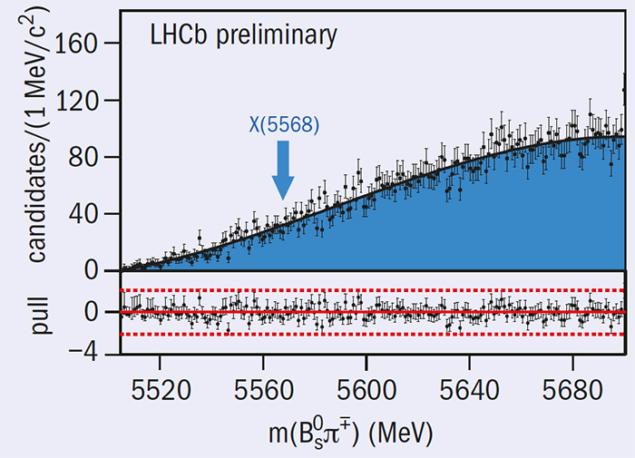
At the Rencontres de Moriond EW conference held at La Thuile (Italy) from 12 to 19 March, the LHCb collaboration presented new important results.

Image credit: LHCb Collaboration.
CKM γ-angle measurements. The parameters that describe the difference in behaviour between matter and antimatter, known as CP violation, are constrained in the so-called CKM, or unitarity, triangle. The angles of this triangle are denoted α, β and γ, and among these, γ is the least precisely known. The γ value of (70.9+7.1–8.5)° presented at the conference was obtained from a combination of many different LHCb measurements, and is the most precise determination of γ from a single experiment. One of the new analyses presented at the conference uses decays of charged B mesons into charmed D mesons and pions or kaons. In turn, the D mesons decay into various combinations of pions and kaons. The results show different rates of positive and negative B mesons, clearly indicating different properties of matter and antimatter.
Determination of the B0 oscillation frequency. A fascinating feature of quantum mechanics, in which the B0s, B0 and D0 particles turn into their antimatter partners, is called oscillation or mixing. LHCb physicists analysed the full Run 1 data sample of semileptonic B0 decays with charged D or D* mesons, and presented the most precise single measurement of the parameter that sets the B0-meson oscillation frequency to be Δmd = (505.0±2.1±1.0) ns–1.
Non-confirmation of the X(5568) tetraquark candidate. Recently, the DZero collaboration at Fermilab reported the observation of a narrow structure, X(5568), in the invariant mass of the B0s meson and a charged-pion π (CERN Courier April 2016 p13), and interpreted it as a tetraquark candidate composed of four different quarks (b, s, u and d).
At the Moriond conference, the LHCb collaboration reported a result of a similar analysis using a sample of B0s mesons 20 times higher than that used by the DZero collaboration. The B0sπ invariant mass spectrum is shown in the figure, using the B0s mesons decaying into J/ψ and φ mesons or into Ds and π mesons. No structure is seen in the region around the mass of 5568 MeV (indicated by the arrow). Hence, the LHCb analysis does not confirm the DZero result. Using similar kinematic requirements applied by the DZero collaboration in their analysis, the ratio of the X(5568) to the B0s-meson production rate is found to be less than 1.6%, at 90% confidence level.







